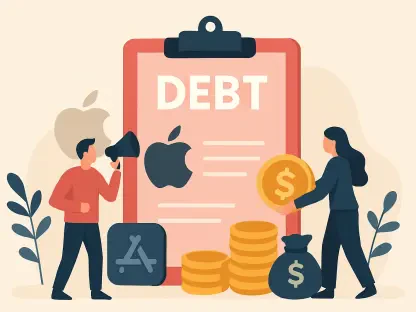Imagine a financial titan like Goldman Sachs, a powerhouse in global investment banking, navigating the turbulent waters of the consumer retail sector with a fresh face at the helm of its strategic operations. On August 4, the firm announced Marko Ratesic as the new vice chairman of its consumer retail group, a move that has sparked widespread interest among industry observers. This roundup gathers diverse perspectives, insights, and analyses from various industry voices to explore what this appointment means for Goldman Sachs and the broader landscape of consumer retail investment banking. The purpose is to dissect the implications of Ratesic’s role through a multifaceted lens, offering readers a comprehensive view of this pivotal leadership transition.
Diverse Voices on Ratesic’s Strategic Appointment
Industry Reactions to a Seasoned Leader
Financial analysts across major publications have expressed optimism about Marko Ratesic’s elevation to vice chairman at Goldman Sachs. Many highlight his extensive tenure since joining the firm in 2006, noting that his progression through key roles—such as managing director by 2009 and partner by 2016—demonstrates a deep understanding of the bank’s inner workings. A common sentiment among banking commentators is that his experience positions him uniquely to tackle the complexities of consumer retail deals in an era of rapid market shifts.
Another angle brought forward by market strategists focuses on Ratesic’s operational background as chief operating officer of the financial and strategic investors group in the Americas. This dual responsibility, while challenging, is seen as a strength by some, who argue that his operational acumen will bring a grounded perspective to high-level strategic decisions. However, a few caution that juggling these roles might strain focus, potentially testing his ability to prioritize amid competing demands in a high-stakes sector.
Significance for Goldman’s Market Position
Insights from investment banking forums suggest that Ratesic’s appointment aligns with Goldman Sachs’ aggressive push to solidify its dominance in consumer retail. Commentators point to the firm’s involvement in monumental transactions, like advising on Mars’ $36 billion acquisition of Kellanova, as evidence of its clout. Industry watchers largely agree that placing a veteran like Ratesic in this role signals a commitment to maintaining momentum in securing such transformative deals.
A differing opinion emerges from smaller advisory firms, where some professionals question whether large banks like Goldman can sustain agility in a sector increasingly influenced by niche players and digital disruptors. These voices argue that while Ratesic’s track record is impressive, the true test will be his ability to adapt traditional banking models to meet evolving client expectations. This debate underscores a broader tension in the industry about balancing legacy strength with innovative flexibility.
Sector Trends and Leadership Implications
Consumer Retail Dynamics Under Scrutiny
Analysts from economic think tanks have weighed in on how Ratesic’s leadership arrives at a critical juncture for consumer retail, marked by heightened merger activity and digital transformation. Many note that Goldman’s recent deals, such as Sycamore Partners’ $10 billion purchase of Walgreens Boots Alliance, reflect a trend toward consolidation that reshapes market landscapes. The consensus among these experts is that Ratesic will need to leverage data-driven strategies to guide clients through this consolidation wave.
A contrasting perspective from retail-focused consultants emphasizes regional disparities in deal-making priorities. While U.S. markets may prioritize large-scale mergers, global markets often demand tailored approaches due to varying regulatory environments. These consultants suggest that Ratesic’s success could hinge on customizing Goldman’s advisory services to address such nuances, a point of view that adds depth to discussions about global versus local strategies.
Challenges of Innovation Versus Tradition
Technology sector commentators bring a fresh angle, questioning whether traditional investment banking can withstand the rise of fintech competitors under leaders like Ratesic. Many argue that consumer retail clients now expect digital-first solutions, pushing banks to integrate advanced analytics and automation. There’s a shared belief that Goldman must innovate to stay relevant, with Ratesic potentially spearheading tech-driven advisory models.
On the flip side, veteran bankers advocate for the enduring value of personal relationships in deal-making. They contend that while technology is vital, trust built through direct client engagement remains irreplaceable. This viewpoint suggests that Ratesic’s client-centric track record could be his greatest asset, provided he balances it with technological advancements to meet modern demands.
Client Trust and Strategic Vision
Building Confidence in a Competitive Arena
Insights from client-facing professionals in investment banking stress the importance of leadership in fostering trust, especially in volatile sectors like consumer retail. Ratesic’s history of working closely with financial sponsors is often cited as a strong indicator of his ability to maintain client confidence. Many believe his approach could set a benchmark for personalized advisory services at Goldman Sachs.
A differing take from risk management experts highlights potential pitfalls in overemphasizing client relationships at the expense of broader market analysis. They argue that while Ratesic’s interpersonal skills are commendable, he must also prioritize comprehensive risk assessments to safeguard against market volatility. This perspective introduces a cautionary note into the otherwise positive narrative surrounding his appointment.
Envisioning Future Engagement Models
Speculation among industry thought leaders centers on how Ratesic might redefine Goldman’s engagement with consumer retail clients. Some predict a shift toward more integrated solutions that combine financial advisory with operational insights, drawing on his dual expertise. This forward-thinking approach is seen as a potential differentiator in a crowded market.
Meanwhile, boutique firm advisors offer a more conservative outlook, suggesting that drastic changes might alienate long-standing clients accustomed to Goldman’s established methods. They propose a gradual evolution rather than a complete overhaul, emphasizing the need to preserve the firm’s reputation for reliability. This divergence in thought reflects the delicate balance Ratesic must strike in his new role.
Reflecting on Key Takeaways
Looking back, the roundup of opinions on Marko Ratesic’s appointment as vice chairman of Goldman Sachs’ consumer retail group reveals a spectrum of insights, from optimism about his seasoned expertise to concerns over balancing tradition with innovation. The discussions underscore the firm’s pivotal role in landmark deals and the broader trends shaping the sector. For those keen to delve deeper, exploring upcoming transactions facilitated by Goldman Sachs or analyzing consumer retail investment patterns offers a practical next step. Additionally, keeping an eye on how leadership transitions influence strategic priorities in investment banking could provide valuable foresight into market dynamics.









